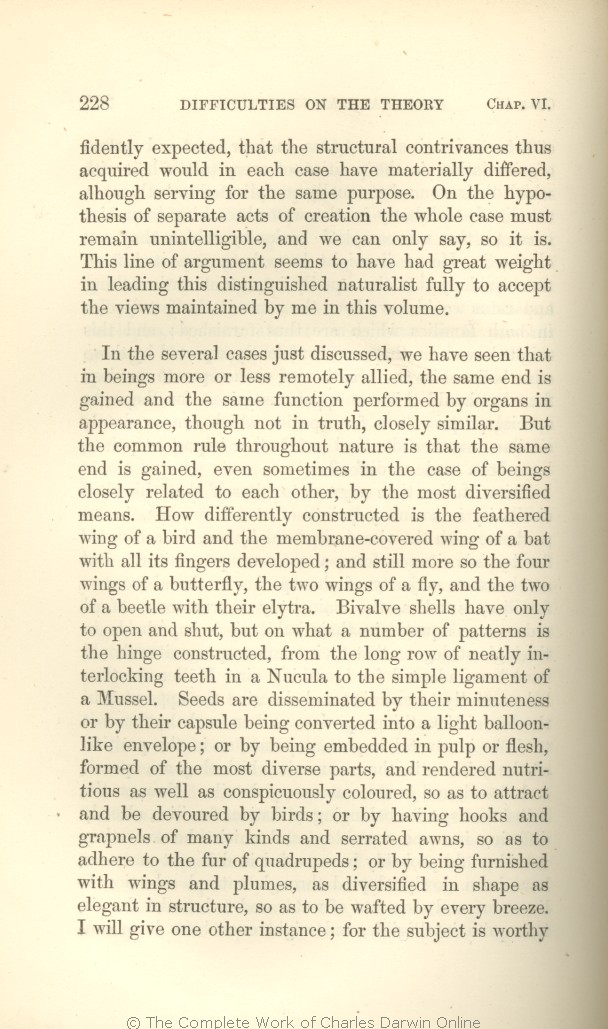fidently expected, that the structural contrivances thus acquired would in each case have materially differed, although serving for the same purpose. On the hypothesis of separate acts of creation the whole case
must
remain | remain 1866 | | remains 1869 1872 |
| unintelligible, 1866 | | unintelligible. 1869 1872 |
| This 1866 1872 | | The above 1869 |
| argument 1866 1872 | | argument, 1869 |
| seems 1866 1872 |
| as advanced by Fritz Müller, seems 1869 |
| this distinguished naturalist fully 1866 |
| this distinguished naturalist 1869 |
| Fritz Müller 1872 |
| 3 blocks not present in 1859 1860 1861 1866 1869; present in 1872 | | Another distinguished zoologist, the late Professor Claparède, has argued in the same manner, and has arrived at the same result.
He shows that there are parasitic mites (Acaridæ), belonging to distinct sub-families and families, which are furnished with hair-claspers.
These organs must have been independently developed, as they could not have been inherited from a common progenitor; and in the several groups they are formed by the modification of the fore-legs,— of the hind-legs,— of the maxillæ or lips,— and of appendages on the under side of the hind part of the body.
|
|
In the
several | several 1866 1869 | | foregoing 1872 |
| cases 1866 1869 | | cases, 1872 |
| just discussed, we have seen that 1866 1869 |
| we see the same end gained and the same function performed, 1872 |
| more or less 1866 1869 |
| not at all or only 1872 |
| the same end is gained and the same function performed 1866 1869 |
| OMIT 1872 |
| truth, 1866 1869 | | development, 1872 |
| common 1866 1869 |
| other hand, it is a common 1872 |
| is 1866 1869 | | should be 1872 |
| beings 1866 1869 | beings 1872 |
| closely related to 1866 1869 |
| closely-related 1872 |
| each other, 1866 1869 | | beings, 1872 |
| with all its fingers developed; 1866 |
| with all the digits largely developed; 1869 |
| OMIT 1872 |
| of a bettle with their elytra. 1866 |
| wings of a beetle, together with the elytra. 1869 |
| wings with the elytra of a beetle. 1872 |
| have only 1866 | | are made 1869 1872 |
| constructed, 1866 1869 | | constructed,— 1872 |
| Mussel. 1866 | | Mussel! 1869 1872 |
| minuteness or by 1866 |
| minuteness,—by 1869 |
| minuteness,— by 1872 |
| ballon-like 1866 | | balloon-like 1869 1872 |
| envelope; or by 1866 |
| envelope,—by 1869 |
| envelope,— by 1872 |
| nutritious 1866 | | nutritious, 1869 1872 |
| birds; or by 1866 |
| birds,—by 1869 |
| birds,— by 1872 |
| quadrupeds; or 1866 | | quadrupeds,—and 1869 | | quadrupeds,— and 1872 |
| diversified 1866 | | different 1869 1872 |
| elegant 1866 1869 |
| they are elegant 1872 |
| is worthy of reflection by those who are not able to credit that organic beings have been formed in many ways for 1866 |
| of 1869 1872 |
|









